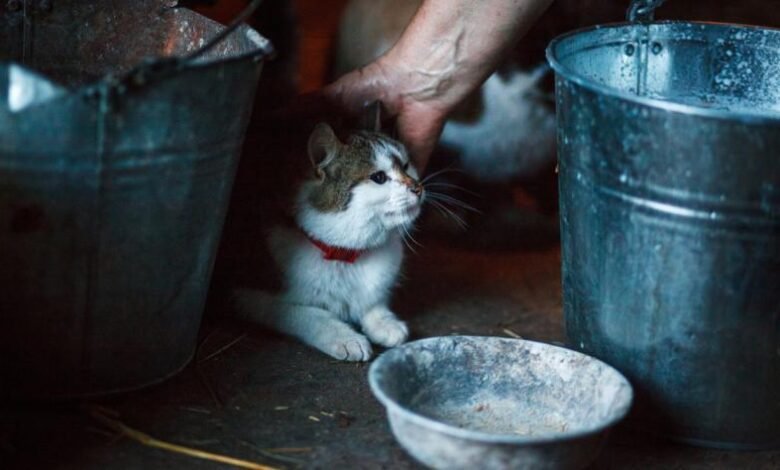Analysis of cow and cat H5N1 bird flu samples raises concerns about spread to other animals

Microbiological examination of samples from cows, milk and cats early in the H5N1 bird flu investigation in some of the first affected states found that cats died soon after being fed raw colostrum from sick cows, highlighting the risk of spread from cows to others cows. animals through contaminated milk.
An Iowa State University research team reported their findings on some of the first samples from cows and cats today. Emerging Infectious Diseases.
For the study, scientists examined samples — milk, serum and tissue — from cows on affected farms in Texas and Kansas. They also analyzed samples from cats that died on farms. Initial discoveries of highly pathogenic H5N1 avian influenza (HPAI) led to the initial announcement by the U.S. Department of Agriculture (USDA) on March 25.
H5N1 in mammary gland cells
The cow tissue samples came from three that were euthanized and three that died naturally. The researchers also carried out post-mortem examinations on two adult cats from one of the farms, which had around 24 cats. The cats began showing symptoms the day after clinical disease was observed in the cows, and about half of the cats died.
Microscopic examination revealed that the H5N1 virus infects epithelial cells in the mammary alveoli where milk is produced, causing acute inflammation in the udder, which could explain the drop in milk production and the high levels of viruses that have appeared in milk.
The authors said the case series shows that H5N1 infection presents more dramatic symptoms in cows than reflected in previous reports of influenza A viruses in animals.
Cats showed symptoms soon after exposure
Meanwhile, they wrote that the clinical disease in cats, especially the neurological symptoms, is consistent with previous reports of H5N1 in cats and follows reports of cats eating infected wild birds and poultry products.
Although consumption of wild birds cannot be ruled out in dairy farm cats, the known consumption of unpasteurized milk and colostrum from infected cows, a fluid that contained a high viral load, makes it a likely route of exposure, the team wrote. .
“Therefore, our findings suggest interspecies transmission of the HPAI H5N1 virus among mammals and raise new concerns regarding the potential for spread of the virus in mammalian populations,” they said.
Ingestion of food contaminated with feces from wild birds is the most likely initial source of infection on dairy farms, according to the authors, who state that more studies are needed to clarify the transmission routes and pathogenesis in infected cattle.
FDA, CDC, USDA Add Updates
In recent days, federal agencies involved in the national H5N1 investigation and response have updated their findings and provided policy clarifications.
Egg inoculation tests were negative for live infectious viruses in retail milk samples that were positive for fragments of H5N1 in previous polymerase chain reaction (PCR) tests, the Food and Drug Administration (FDA) said in a report April 26th. to update. It noted that the test results are preliminary, but confirm its assessment that the commercial supply of milk is safe.
The FDA also said it tested several samples of retail infant formula and powdered dairy products marketed as infant formula, and all were negative for H5N1 remnants in PCR tests.
Work is still ongoing on 297 retail samples from 38 states. The agency said that samples positive in the PCR test will undergo egg inoculation testing.
Meanwhile, the Centers for Disease Control and Prevention (CDC), in a to update on the same day states that its ongoing susceptibility testing on commercially available antiviral drugs has found that the current H5N1 strain is susceptible to baloxavir marboxil (Xofluza).
The CDC said its previous studies showed that the H5N1 virus from the human case in Texas was susceptible to other antivirals, including oseltamivir. However, it said one of 200 publicly published H5N1 samples from dairy cows found a marker with a known link to reduced susceptibility to neuraminidase inhibitors.
“The detection of this marker in one of more than 200 samples is not surprising or concerning at this time in terms of the clinical utility of these drugs, but it underscores why this type of constant monitoring is important,” the agency wrote.
Finally, the US Department of Agriculture (USDA) on April 27 enlightened its recent federal order prohibiting the interstate movement of lactating dairy cows without testing to ensure the animals are not infected with HPAI H5N1.
It said the clarification notes that the order does not apply to the interstate movement of dairy cows going to sales barns, which are sometimes used to consolidate and move cattle for slaughter out of state.. “We are announcing this clarification over the weekend to ensure that small farms have the guidance they need to continue moving cull livestock and limit animal welfare issues,” the USDA said.



